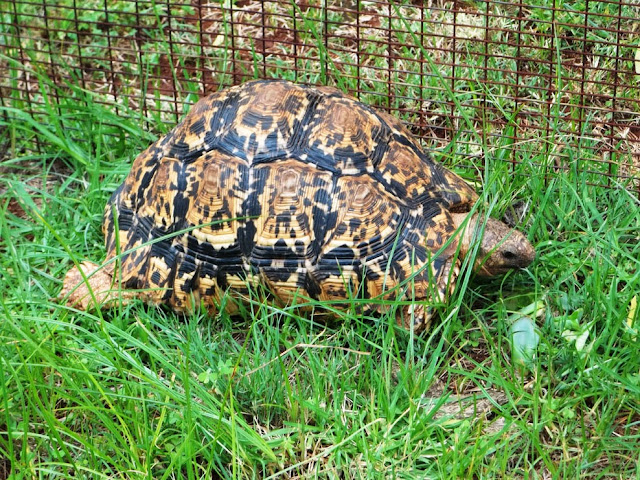This is Torti, my Leopard Tortoise (Stigmochelys pardalis), who has been with me since she was no larger than my hand. Destined for the pot or possibly muti (a term for traditional medicine in Southern Africa), I confiscated her from the aggressor and brought her home. My intention was to release here into a safe environment, but these are becoming less and less due to the area becoming heavily built-up over the last decade.
These tortoises face many dangers like illegal trade in wildlife, body parts being used in traditional medicines, veld fires, road kills and many more. So, right or wrong, she has stayed with me over the past seven years in the hope that some day I will find a perfect area in which to release her.
In the meantime, she comes when I call her every morning for breakfast, taking her time and making me wait while she unhurriedly approaches and then digging in with gusto! She also knows when it's feeding time - if Lydia or I are a bit late (the normal time is about 9.15am), you'll find her impatiently walking up and down the fence, as if to say, "What's the hold-up?!"
Walking the fence while waiting for breakfast
Torti taking her time making her way towards the food
They are large tortoises (largest species in South Africa) that can weigh over 30kg and measure up to 60cm in length. Males have longer tails and a deep plastron (Bottom of shell) concavity as opposed to the females which have short tails and a flat plastron. Colouration is varied and the African Leopard Tortoise typically lives 80 to 100 years.
Torti is now approximately 8 years old and almost too heavy to pick up
The Leopard tortoise (Stigmochelys pardalis) is a large and attractively marked tortoise found in the savannas of eastern and southern Africa, from Sudan to the southern Cape. It is the only member of the genus Stigmochelys, but in the past it was commonly placed in Geochelone instead. This chelonian is a grazing species of tortoise that favors semi-arid, thorny to grassland habitats, although some leopard tortoises have been found in rainier areas. In both very hot and very cold weather they may dwell in abandoned fox, jackal, or anteater holes. Leopard tortoises do not dig other than to make nests in which to lay eggs. Not surprisingly, given its propensity for grassland habitats, it grazes extensively upon mixed grasses. It also favors succulents and thistles, and (in captivity) the fruit and pads of the prickly pear cactus (Opuntia sp.) (cactus are New World plants not native to Africa).
Leopard tortoises are increasingly being bred in captivity. This is a positive development, as it should lead to a gradual reduction in demand for animals caught in the wild. In most cases, wild-caught leopard tortoises are not only loaded with ticks, mites and internal parasites, but they are usually very stressed and dehydrated and may not voluntarily eat.
You can read more on caring for a Leopard Tortoise in my post here
This is Torti's enclosure where she spends her days either exercising by walking the whole area or sunbathing. Tortoises are wanderers and in the wild occupy a home range of from 1 to 3 square kilometers. I used to put a bowl with water for her, but she prefers to drink out of the pond. I used to be worried (and still am!) about her falling into the water, but Leopard tortoises can swim well and will cross rivers or lakes. Unlike most land tortoises, which tend to sink when they fall into water, the leopard tortoise can float and actually likes to swim and can stay underwater for up to 10 minutes. And I've ensured that there are lots of easy flat and shallow points of exit for her just in case.
Torti's enclosure
I often let her out into the garden, but have to stand guard and herd her like a sheep as she heads towards my prize Echeverias! When out in the garden, she takes a keen interest in her surrounds, investigating every nook and cranny. She also loves spending some time under the peach tree eating any fallen peaches.
There's no great benefit to owning a tortoise or having it as a pet. It can't cuddle, it can't chirp back when you talk to it and doesn't take kindly to being carried around - and be prepared for some hard work. Feeding a tortoise and keeping it's enclosure clean is a daily exercise and when you go on holiday, be assured you know someone who is prepared to take on these tasks.
.









No comments:
Post a Comment